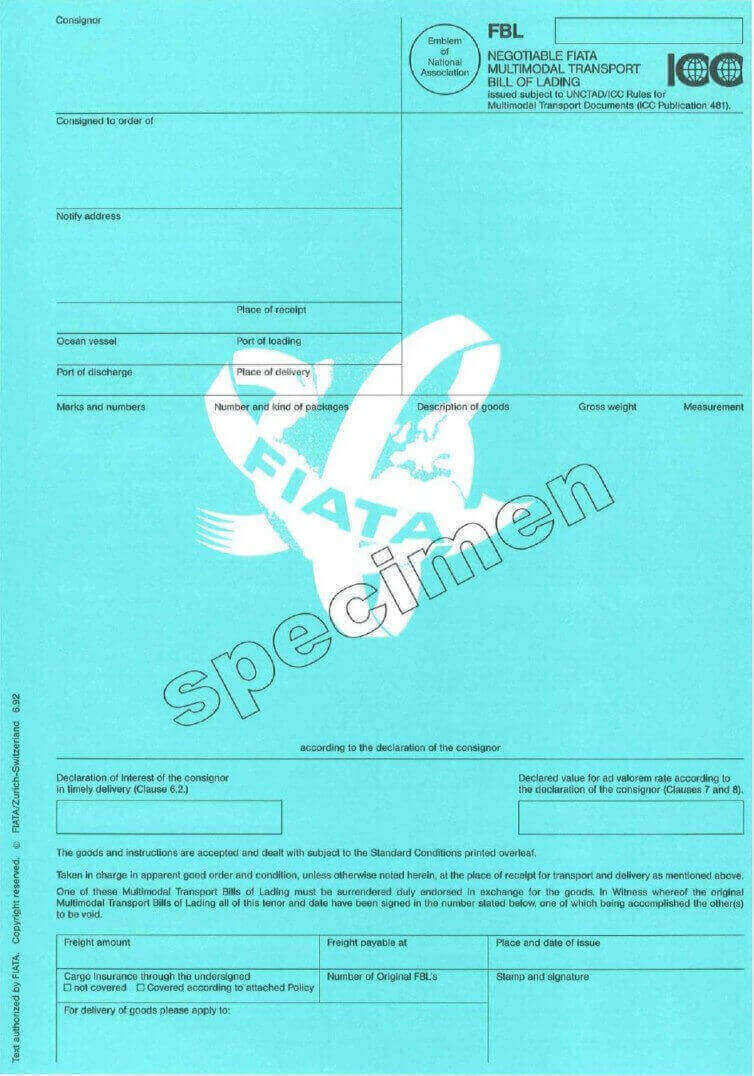On this post, I will explain Negotiable FIATA Multimodal Transport Bill of Lading, a transport document, only issued by freight forwarders, whom are the members of the FIATA (International Federation of Freight Forwarders Associations).
The FBL is an acronym which stands for “Forwarder’s Bill of Lading”, “Fiata Bill of Lading” or “Negotiable FIATA Multimodal Transport Bill of Lading”.
FBL is a one of the oldest and well-known standard transport documents created by FIATA (International Federation of Freight Forwarders Associations) for general use of the freight forwarders in international transportation.
FBL has been restricted to use only by FIATA members.
FBL is printed on a blue color paper.
Fiata logo is positioned in the middle of the FBL transport document. ICC logo, which signifies the ICC approval, can be seen on the right up side of the document.
History of FBL:
First FBL was created in year 1975.
Fiata FBL was acknowledged by ICC in 1993, which means that the Negotiable FIATA Multimodal Transport Bill of Lading is entirely in conformity with the UNCTAD/ICC Rules for Multimodal Transport. Since then FBL carries ICC logo.
Terms and conditions of the carriage have been printed on the reverse side of the FBL document under the title of “Standard Trading Conditions Governing FIATA Combined Transport Bills of Lading”. As a result FBL is not a short form or blank back bill of lading.
FBL is a valid transport document according to letter of credit rules, and has been accepted by banks without any problem, as long as it is issued not in conflict with the conditions stated in respective articles of UCP 600 such as article 19, 20 or 21.
Why Exporters and Importers Use a FBL?
The main reason to use a FBL would be working with a freight forwarder instead of a carrier.
FBL issued by the freight forwarders in the capacity of contractual carriers. They usually sign FBL transport document “as carrier”.
What are the Main Characteristics of a FBL Transport Document?
- FBL includes a contract of carriage and it is a valid transport document according to the letter of credit rules.
- FBL will be issued in a negotiable form as the consignee part of the Fiata multimodal transport bill of lading includes pre-printed “consigned to order of” phrase. Exporters must be very careful with last leg of the transportation in regards to negotiability of the FBL. If the last leg of the transportation is not ended at sea, the FBL document may not be considered as a negotiable instrument.
- FBL transport document can be used not only in multimodal transportation, but also single mode port-to-port sea or land shipments.
- The copyrights of FBL document is owned by FIATA. Only Fiata member freight forwarders could use FBL standard format multimodal bill of lading.
- FBL is entirely in conformity with the UNCTAD/ICC Rules for Multimodal Transport Documents and is approved by ICC.
What are the differences between a FBL (Negotiable FIATA Multimodal Transport Bill of Lading) and a Shipping Line Bill of Lading (SLBL)?
- A Shipping Line Bill of Lading (SLBL) or carrier’s bill of lading is issued by the carrier or its agent on behalf of the carrier. SLBL generally printed on the letterhead of the shipping line. On the reverse side of the SLBL the terms and conditions of carriage of the shipping line are incorporated. This is the best bill of lading option for the beneficiary, the applicant and the banks that enter letter of credit transaction.
- A Negotiable FIATA Multimodal Transport Bill of Lading (FBL) which is also known as Fiata Bill of Lading or Forwarder’s Bill of Lading, is “issued” by a freight forwarder. FBL should be printed on the standard form Fiata FBL format incorporating Fiata and ICC logos. “Standard Trading Conditions Governing FIATA Combined Transport Bills of Lading” has been printed on the reverse side of the FBL. FBL signed by the freight forwarder, as carrier.
